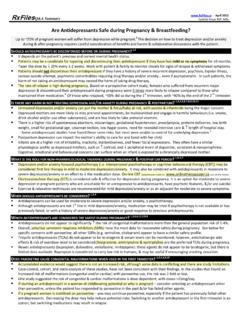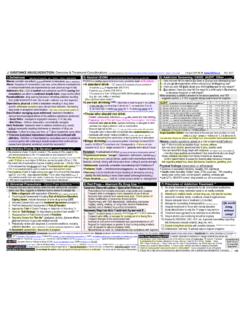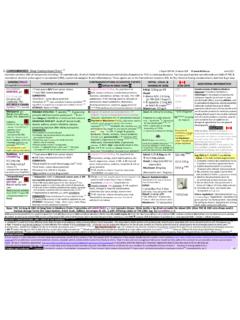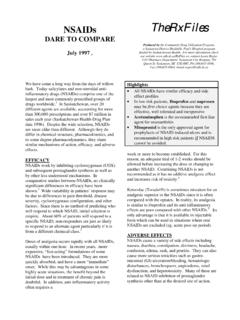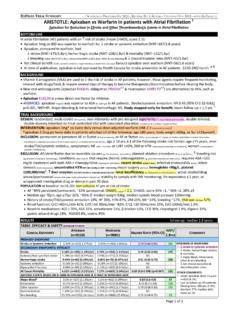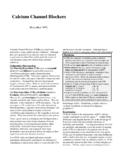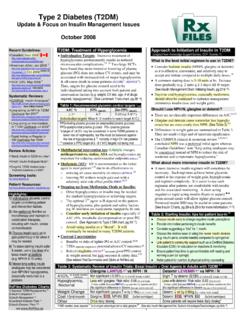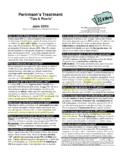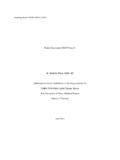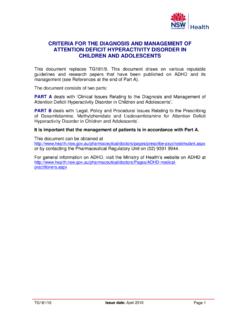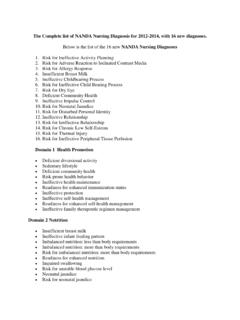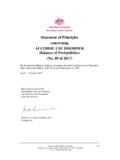Transcription of RxFiles Krahn UofS Regier URGENCY …
1 RxFiles Q&A Summary updated June 2016 K Krahn UofS BSP Student 2014, L Regier BSP, BA HYPERTENSIVE URGENCY ( asymptomatic severe hypertension ): considerations FOR management hypertension is one of the most common chronic medical conditions in Canada. More than one in five Canadians has hypertension and the lifetime risk of developing hypertension is 90%.1 With the addition of comorbid conditions and other risk factors, hypertensive cases can quickly become even more complex. Hypertensive crises include hypertensive urgencies & emergencies.
2 Optimal management lacks conclusive evidence. The rate of associated major adverse cardiovascular events in asymptomatic patients seen in the office are very Since rapid treatment of hypertensive URGENCY is not required, some prefer to call it asymptomatic severe hypertension . WHAT IS HYPERTENSIVE URGENCY & HOW DOES IT COMPARE TO HYPERTENSIVE EMERGENCY? 1,2,3 ,4,5,6,7,8,9 The term hypertensive crises can be further divided into hypertensive URGENCY and hypertensive emergency. The distinction between these two conditions is outlined Differentiating between these scenarios is essential before initiating treatment.
3 URGENCY 2 9 EMERGENCY 2 9 Blood Pressure (mmHg) >180 systolic &/or >120 >130 CHEP diastolic Target Organ Damage* No Yes: currently experiencing ( aortic dissection, angina/ACS, stroke, encephalopathy, acute renal failure, pulmonary edema, eclampsia) Symptoms asymptomatic ; or severe headache, shortness of breath, nosebleeds, severe anxiety Shortness of breath, chest pain, numbness/weakness, change in vision, back pain, difficulty speaking *Note: Signs of end organ damage/dysfunction may occur at a lower blood pressure in pregnant & pediatric patients Initial Patient Work Up to Differentiate between URGENCY and Emergency: Verify blood pressure (BP) reading(s).
4 Ensure proper technique for measuring BP ( patient s feet flat on the floor & arm supported) (Please refer to hypertension Canada s Blood Pressure Measurement Information Sheet for more detailed guidance). Obtain medical history & current medication list (prescription, OTC, recreational) Physical exam focus on any signs of target organ damage ( shortness of breath, chest pain, numbness/weakness) Lab tests & investigations may be required ( CBC, ECG, urinalysis, renal function; ultrasound for aortic dissection if very high BP) Hypertensive URGENCY is not an emergency and its management is much less aggressive (see below).
5 Diagnosis of a hypertensive emergency requires rapid intervention to lower BP in the emergency department ( IV nitroprusside, IV labetalol, or IV nicardipine).2 12 WHAT CAUSES HYPERTENSIVE URGENCY ? Most patients presenting with hypertensive URGENCY have been previously diagnosed with hypertension . severe BP elevations may result from inadequate control on or poor adherence to current antihypertensive drug 8 Another cause for patients reaching hypertensive URGENCY or emergency is previous inaccurate BP measurements that underestimate or do not detect increased BP at all ( poor patient technique for self monitoring).
6 A patient s BP can also be elevated by other factors, including: o Drugs 1 - Prescription: ADHD medications ( methylphenidate), antidepressants ( venlafaxine, buproprion, desipramine), calcineurin inhibitors ( cyclosporine, tacrolimus), corticosteroids, estrogens, midodrine, NSAIDs ( ASA, ibuprofen, naproxen, diclofenac, celecoxib), testosterone, triptans - Non Prescription: decongestants ( pseudoephedrine, phenylephrine), NSAIDs (ibuprofen, naproxen), topical ASA or diclofenac Cautions: a) often these are not on a patient s profile; b) use of combination products may result in inadvertent use - Herbal: black licorice root, ginkgo biloba, St.
7 John s Wort. Consider potential for undeclared ingredients/adulterants. - Recreational: stimulants ( amphetamines like crystal meth or ecstasy), anabolic steroids, caffeine, cocaine, phencyclidine. Energy drinks containing taurine, guarana root, yerba mate, glucuronolactone, etc. o Lifestyle 1 High salt diet, excessive alcohol use. o Comorbid Conditions 2 - Thyroid storm, trauma, renovascular disease, acute ischemic stroke or adrenal dysfunction Some population groups are more likely to experience hypertensive URGENCY 10: Elderly; African Americans; Men > Women HOW SHOULD HYPERTENSIVE URGENCY BE MANAGED?
8 1 11 Overall Goal of management : reduce SBP by ~ 25% over 24 48 hours. More conservative BP lowering reduces the risk of potential adverse effects ( perfusion complications worsening incidence of MI, stroke, and death) associated with more aggressive BP All treatment strategies should consider the patient s comorbidities and risk of adverse Don t just treat the number !!! 1) All patients should be provided with a quiet room to rest. This will be adequate for >30%, leading to a fall in BP of 10 20 mmHg. 2) Tilt the head of the bed 15 degrees up.
9 This may also help to decrease BP. 3) If BP remains above 180/100 mmHg for 3 hours, consider antihypertensives. 4) General drug treatment options differ depending on whether the patient was previously diagnosed with & treated for hypertension . Previously Treated hypertension : trying one the following may be appropriate interventions (in no particular order) - Restart/resume medications in non adherent patients - Increase the dose of current antihypertensive medications - Add another antihypertensive agent from another class Untreated hypertension .
10 Choice of treatment depends on patient and the setting ( emergency room versus doctor s office) - Temporary use of fast acting oral antihypertensives ( clonidine, labetalol, captopril) may be used to gradually reduce BP over several hours, depending on the condition of the patient. The following page highlights potential options. - However, reduction of BP over 24 48 hours with longer acting agents ( ramipril 10 mg, metoprolol SR (or XLUSA) 100 mg, or nifedipine XL 30 mg) is usually preferred over temporary use of short acting agents. Continued on next & optimize hypertensive regimen!

